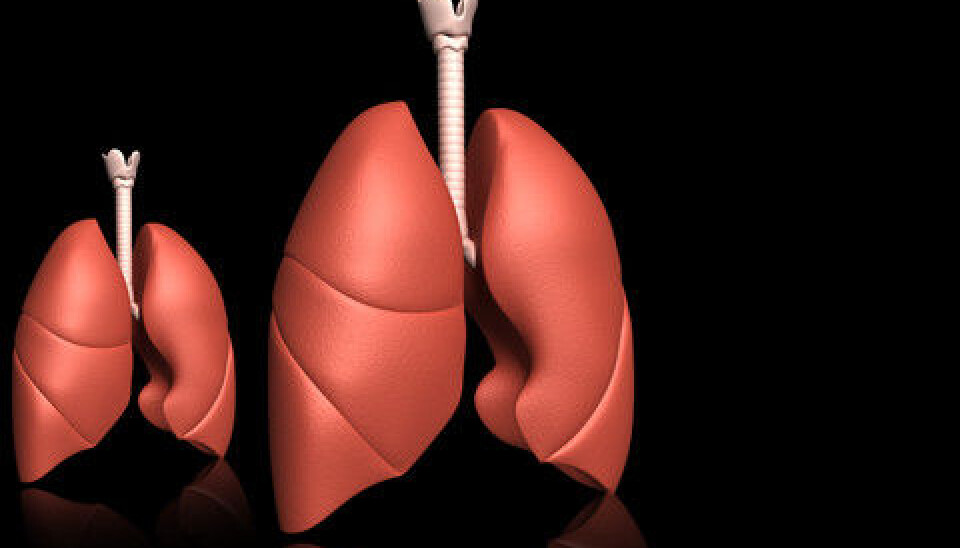
COPD lung disease ages the body
If you are one of the many people who suffer from the COPD lung disease, your cells may wear out prematurely, new study shows.
Decreased lung function and the COPD lung disease not only reduce the quality of your life here and now; they can also shorten your life by eroding the cells in your body.
This is the conclusion of a comprehensive new study by researchers at Herlev Hospital and Copenhagen University.
”Our study shows that people with worn-out cells are 15 percent more likely to develop COPD or decreased lung function,” says one of the researchers behind the study, Line Rode, MD, of the Department of Clinical Biochemistry at Herlev Hospital.
”So there’s a correlation between COPD and wear and tear of body cells – a correlation which we have yet to fully understand, but which can probably lead to a new way of identifying people who already have or who are at risk of developing these diseases.”
COPD stands for Chronic Obstructive Pulmonary Disease and is a lung disease which makes it hard to breathe. COPD is often a mix of two diseases: chronic bronchitis and emphysema. It is projected to become the fourth leading cause of death worldwide by 2030.
Protective chromosome tips cut off
The researchers determined the levels of wear and tear in the cells by measuring the length of their so-called telomeres – the tips of the chromosomes – which protect the cell’s viral genetic material, DNA.
Every time the cell divides, a piece is cut off the telomeres, and eventually there is nothing left to cut off. Once these protective tips are gone, the cells cease to function and their host dies.
Natural ageing thus shortens the cells’ telomeres, but the research group has shown in a previous study that unhealthy habits such as smoking can accelerate this effect.
The cause has so far not been known, but Rode and her colleagues believed that the smoke shortens the telomeres indirectly either by provoking inflammation in the lung tissue, by impairing the lungs’ ability to absorb oxygen or by jumpstarting the lung disease COPD.
Data from blood samples
To test their hypothesis, they gathered telomere data from 46,396 Danes through blood samples which had been collected from two large population studies, the Copenhagen City Heart Study and the Copenhagen General Population Study.
A special biochemical technique enabled the researchers to measure the length of each participant’s telomeres, after which the figures were adjusted for differences in age and BMI.
The participants also had their lung function measured. This can reveal whether a person has COPD and how hard they are hit by the disease.
Large studies are more reliable
They found a clear link between the two factors; however, this link was significantly weaker than what similar smaller studies had found. Whereas the old studies with a couple of hundred participants suggested that short telomere length was associated with a 28-fold increased risk of COPD, the new study found that short telomeres only increase the risk by 1.15.
“The other studies were small, and the participants were more hand-picked than ours,” says Professor Børge Nordestgaard, also of Copenhagen University, who headed the study.
“Our study therefore provides a stronger indication of the correlation in the general population. The size of our study also enabled us to adjust for more factors than the smaller studies did.”
The immune system plays a central role
It’s now clear that there’s a link between telomere-length and COPD. However, the researchers cannot say at this point whether it’s the COPD that shortens the telomeres or vice versa. The study doesn’t say anything about that, and in principle there could be a third factor causing both.
The researchers are looking at three main theories:
1. COPD patients are more susceptible to infections that stress the immune system and make it produce more white blood cells, whose job it is to neutralise viruses and bacteria and rebuild damaged tissue. The body builds up an army of white blood cells by making existing cells divide, and this division shortens the telomeres. This wears out the cells so that they age faster than they normally would.
2. The immune defence in people with worn telomeres functions worse than normal because its white blood cells are less capable of dividing. The consequence is that the body develops more diseases, including COPD.
3. Cigarette smoke and other external substances irritate the lung tissue to such a degree that the body’s immune defence starts producing more white blood cells to fight the smoke particles and its harmful effects. But instead of attacking the smoke, the white blood cells attack the lung tissue, which becomes impaired. The result is decreased lung function and COPD.
Stress and obesity have the same effect
The new study is the first step towards helping COPD patients. In the long term, it might be possible to use telomeres as a tool for identifying which people have short telomeres and whose lungs are extra sensitive to smoke particles.
”There are indications that telomeres can be used as a pointer on how risky a life a person lives. We can use this information to help determine which lifestyle factors can affect our cells and cause various diseases,” says Rode.
Other studies have also shown that smoking can chop pieces off the cells’ telomeres. Similar correlations have been found for both obesity and stress.
--------------------------------------
Read the Danish version of this article at videnskab.dk
Translated by: Dann Vinther
Scientific links
External links
- Line Rode’s Linkedin profile
- Børge Nordestgaard’s profile
- About telomeres (Wikipedia)
- About COPD (Wikipedia)







